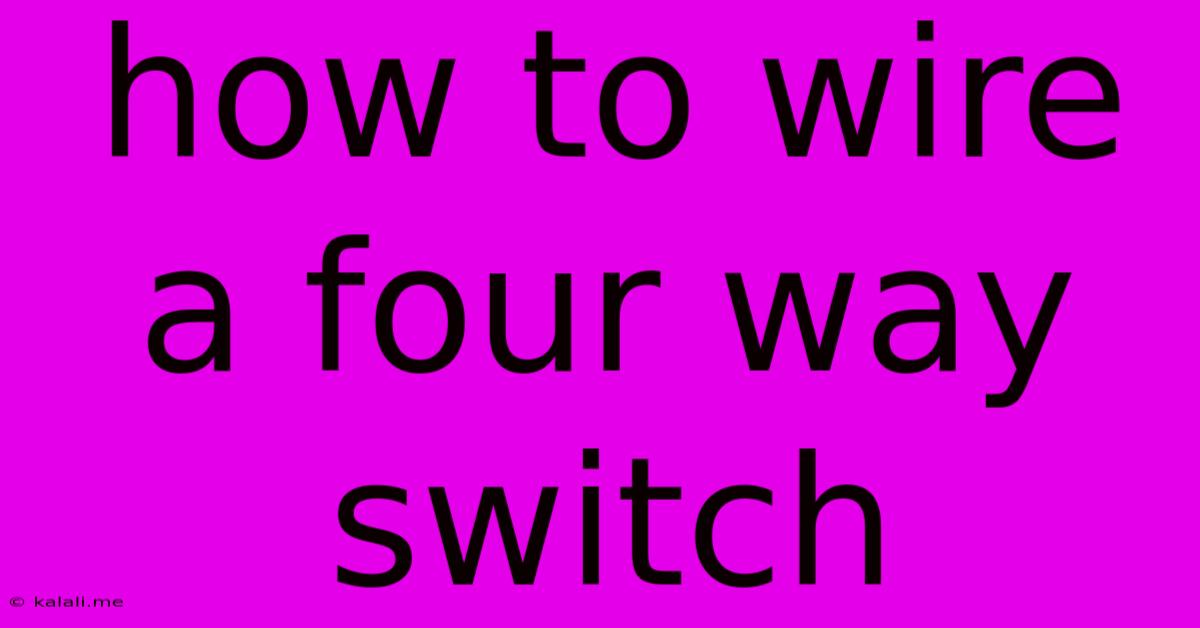How To Wire A Four Way Switch
Kalali
Jun 02, 2025 · 4 min read

Table of Contents
How to Wire a Four-Way Switch: A Comprehensive Guide
Wiring a four-way switch can seem daunting, but with a clear understanding of the process, it becomes manageable. This comprehensive guide will walk you through each step, ensuring you can successfully add this versatile switching option to your home's electrical system. This guide covers the basics of four-way switching, the tools and materials you'll need, the wiring process, and important safety precautions. Remember, working with electricity can be dangerous. If you're unsure about any part of this process, consult a qualified electrician.
Understanding Four-Way Switching: Unlike a single-pole switch that controls a light from one location, or a three-way switch that allows control from two locations, a four-way switch allows you to control a light fixture or other electrical device from three or more locations. This is achieved by using a combination of three-way and four-way switches. The four-way switch acts as a "link" between the three-way switches, allowing the signal to be passed along the circuit. This is perfect for controlling lights on long hallways, staircases, or large rooms.
Tools and Materials You'll Need:
- Four-way switch: Make sure you purchase a switch that's compatible with your existing wiring and electrical box.
- Three-way switches (if needed): You'll need these if you're expanding an existing two-way switching system.
- Electrical wire strippers/cutters: To safely remove insulation from the wire ends.
- Screwdriver (Phillips and flathead): For securing screws on the switches and electrical boxes.
- Voltage tester: Crucial for safety, to ensure the power is off before you begin.
- Wire nuts (wire connectors): To securely join wires together.
- Electrical tape (optional): Provides extra insulation and helps keep things tidy.
- Fish tape or wire snake (if needed): To pull new wires through walls or ceilings.
Step-by-Step Wiring Instructions:
1. Turn Off the Power: This is the most crucial step. Turn off the breaker controlling the circuit you'll be working on. Use your voltage tester to double-check that the power is completely off at the switch location and the light fixture.
2. Access the Switch Boxes: Carefully remove the switch plates and access the wiring in each electrical box. Take photos of the existing wiring before disconnecting anything – this will be invaluable if you need to refer back later.
3. Identify the Wires: Typically, you'll find three or more wires in a four-way switch setup. These will usually be a black (hot), white (neutral), and a ground wire (bare copper or green). There will also be two traveler wires (usually black or red) which connect the four-way switch to the three-way switches.
4. Disconnect the Existing Wires: Carefully unscrew the wire nuts connecting the wires to the old switch. Keep track of which wire connects to which terminal.
5. Connect the New Four-Way Switch: The four-way switch has usually four terminals: two for traveler wires (commonly labeled as "common" or "COM" and "traveler" or "TRAV"). Connect the two traveler wires from the three-way switches to the labeled terminals. If you have more than one set of traveler wires, ensure the wires from the same three-way switch are connected to the same terminal on the four-way switch.
6. Reconnect the Wires: Carefully connect all the wires to their corresponding terminals on the new switch using wire nuts. Make sure the connections are secure and no bare wires are exposed.
7. Test the Circuit: Turn the power back on at the breaker and test the switch from all locations. The light should turn on and off as expected from each switch.
8. Secure and Finish: Tuck the wires neatly into the electrical box and replace the switch plate.
Troubleshooting:
If the light doesn't work after you've completed the wiring, double-check the following:
- Power is off at the breaker: The power must be off before any wiring changes.
- Wires are securely connected: Loose connections are a common cause of problems.
- Correct wire identification: Ensure that the hot, neutral, and traveler wires are correctly connected to the switch terminals.
- Circuit breaker is tripped: Check if the breaker has tripped during the process.
Wiring a four-way switch requires patience and attention to detail. By carefully following these steps and prioritizing safety, you can successfully add this valuable feature to your home’s electrical system. Remember to consult a qualified electrician if you encounter any difficulties or feel uncomfortable working with electrical wiring.
Latest Posts
Latest Posts
-
Does Reduction Mean Loss Or Gain Or Electron
Jun 04, 2025
-
How To Keep Water From Freezing In Minecraft
Jun 04, 2025
-
Minecraft Could Not Connect Outdated Client
Jun 04, 2025
-
How To Say Gay In Japanese
Jun 04, 2025
-
How Long Does Gasoline Last In A Gas Can
Jun 04, 2025
Related Post
Thank you for visiting our website which covers about How To Wire A Four Way Switch . We hope the information provided has been useful to you. Feel free to contact us if you have any questions or need further assistance. See you next time and don't miss to bookmark.